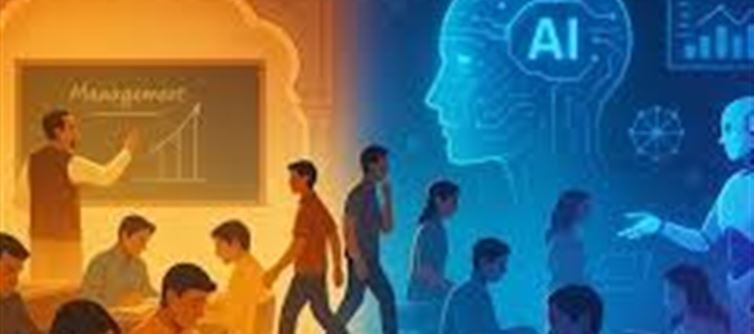
In today’s fast-paced world, artificial intelligence (AI) is transforming industries across the globe, and business schools are under increasing pressure to ensure that their students are equipped with the skills needed to thrive in this new environment. The question is: Are indian B-schools integrating AI effectively into their curriculum to prepare the next generation of leaders?
1. AI: The Missing Link to Future-Ready business Leaders
In the rapidly evolving business landscape, AI is no longer a futuristic concept—it is a reality that is driving change across industries. From automated decision-making to data analytics and customer personalization, AI is enabling businesses to become more efficient and competitive.
Indian B-schools are aware of the need for students to acquire AI proficiency, but the extent to which they are integrating AI into their business education varies. Some institutes are ahead of the curve, offering AI-focused electives, while others are still catching up, struggling to align traditional business education with the needs of a data-driven future.
2. The Current Landscape of AI Integration in indian B-Schools
Many top indian business schools, such as IIMs (Indian Institutes of Management) and XLRI, have started offering specialized courses on AI, machine learning (ML), and data analytics. However, there is still a gap between the theoretical knowledge imparted and the real-world applications of AI in business.
· Curriculum Updates: Some B-schools have made strides by introducing AI modules in their MBA programs, focusing on how AI can enhance strategy, marketing, and operations. Institutions like IIM Bangalore and ISB have partnered with tech companies to bring AI into their curriculum.
· Industry Partnerships: Collaboration with tech giants like Microsoft, Google, and IBM has allowed several schools to stay up-to-date with the latest trends in AI. For example, IIM Calcutta offers a Post Graduate Certificate in business Analytics, which incorporates AI and ML tools for business decision-making.
· AI in Specializations: AI is being integrated into specialized fields such as digital marketing, financial analytics, and supply chain management. For example, IIM Ahmedabad and IIM Lucknow have introduced digital transformation courses that include AI-related topics.
3. Bridging the Gap: AI’s Role in Closing the Curriculum-Industry Divide
One of the key challenges faced by indian B-schools is the need to bridge the gap between academic curriculum and industry demands. While the traditional MBA programs are rich in foundational knowledge like finance, marketing, and strategy, they often fail to prepare students for the data-driven world that businesses operate in today.
· Practical Learning: Many B-schools are starting to emphasize hands-on learning through AI-driven case studies, simulations, and internships. These initiatives help students apply AI concepts in real-world scenarios, ensuring that they understand how to leverage AI for strategic decision-making.
· Industry Experts and AI Workshops: Leading B-schools have begun inviting AI experts and industry leaders to conduct workshops, webinars, and guest lectures. These sessions help students gain practical insights into how AI is shaping business operations and how they can incorporate AI tools into their future roles.
4. Challenges Faced by indian B-Schools in Adopting AI
While the shift towards AI in business education is happening, there are challenges:
· Lack of Infrastructure: Many smaller B-schools may not have the necessary infrastructure to implement AI and data science modules effectively. The availability of computing power, access to AI tools, and faculty expertise are key hurdles.
· Faculty Training: The pace of AI advancements is so rapid that many educators themselves need to continuously update their skills to keep up. Faculty development programs in AI are still in their nascent stages in several institutions.
· Industry-Relevant AI Applications: Some business schools still struggle to ensure that their AI curriculum is fully aligned with the evolving needs of industries. There’s a need for more collaborations between B-schools and tech companies to ensure that the curriculum remains relevant.
5. The Way Forward: Embracing AI Across the Board
To keep pace with the future, indian B-schools must take several steps to integrate AI more effectively into their offerings:
· Curriculum Overhaul: B-schools should introduce AI fundamentals in the core curriculum, not just as an elective or niche course. students should learn about AI’s applications in areas such as business forecasting, customer experience management, and data-driven decision-making from day one.
· Industry Tie-ups: More industry collaborations will ensure that students get exposure to real-life AI applications. These partnerships will also allow students to work on live projects using AI tools and platforms.
· Focus on Data Literacy: AI literacy alone won’t be enough. business students also need a deep understanding of data analytics. Offering data science and AI-driven business analytics as core subjects could go a long way in preparing students for the AI-first future.
Conclusion: The Road Ahead for indian B-Schools and AI
While some indian B-schools are already taking steps to incorporate AI into their curricula, the journey towards future-ready business education is far from complete. To equip the next generation of business leaders, B-schools need to go beyond theoretical knowledge and incorporate AI into all aspects of business education—starting with leadership, strategy, and decision-making.
AI might just be the missing link that transforms indian B-schools into powerhouses of innovation and equips students with the skills required to lead in an AI-powered business world.
Disclaimer:
The views and opinions expressed in this article are those of the author and do not necessarily reflect the official policy or position of any agency, organization, employer, or company. All information provided is for general informational purposes only. While every effort has been made to ensure accuracy, we make no representations or warranties of any kind, express or implied, about the completeness, reliability, or suitability of the information contained herein. Readers are advised to verify facts and seek professional advice where necessary. Any reliance placed on such information is strictly at the reader’s own risk..jpg)




 click and follow Indiaherald WhatsApp channel
click and follow Indiaherald WhatsApp channel